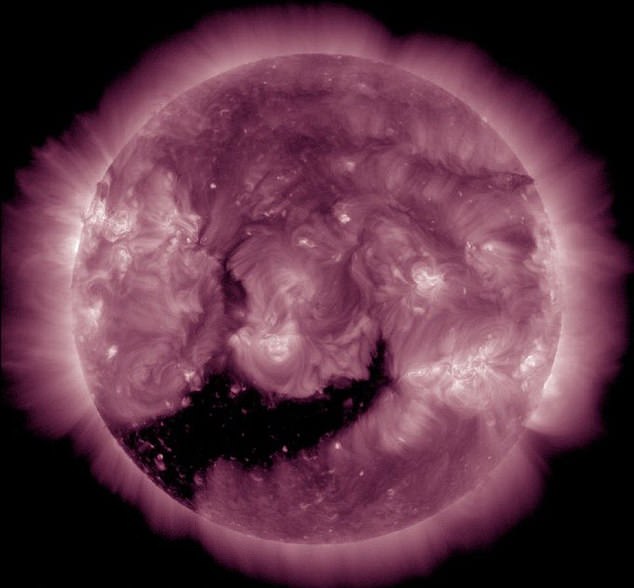
Dramatic Solar ‘Claw’ Eruption Sparks Powerful Earth-Bound Shockwave Within Hours
Sun’s Giant Coronal Hole Sparks Geomagnetic Storm, Possible Aurora Sightings
[Image: A massive, dark coronal hole on the sun’s surface.]
A giant coronal hole has opened on the sun, unleashing high-speed solar winds toward Earth. This stream of charged particles, traveling at hundreds of miles per second, is expected to trigger a moderate G2-level geomagnetic storm by Friday, potentially causing power grid fluctuations, satellite disruptions, and vibrant auroras visible as far south as Michigan and Maine.
What’s Happening?
Coronal holes are regions where the sun’s magnetic fields weaken, allowing solar wind to escape into space. This claw-shaped gap, spanning nearly the width of 60 Earths, is generating a Coronal Hole High-Speed Stream (CH HSS) that could compress Earth’s magnetic field upon impact. The resulting shockwave, known as a Co-Rotating Interaction Region (CIR), may amplify disruptions to power systems, radio signals, and GPS accuracy—especially near the poles.
Impacts on Earth
Officials warn of potential transformer damage in high-latitude regions and minor power grid fluctuations, like those observed in Michigan. While the storm is moderate, it could temporarily affect satellite orbits, aviation navigation, and spacecraft instruments. By Sunday, activity is expected to weaken to a G1-level storm.
Aurora Alert
[Image: Colorful northern lights illuminating a night sky.]
The solar storm may also bring dazzling auroras to northern U.S. states, including New York and Idaho, with optimal visibility in Canada. Auroras occur when solar particles collide with atmospheric gases, creating glowing curtains of light. Clear, dark skies will offer the best views.
Solar Cycle Threats
This event coincides with the sun’s “solar maximum,” a peak phase in its 11-year cycle marked by heightened activity like sunspots, solar flares, and coronal mass ejections (CMEs). While G2 storms are common (occurring ~360 times per cycle), experts emphasize that extreme space weather remains a critical threat.
Emergency Drill Exposes Vulnerabilities
A recent “solar storm emergency drill” simulated a worst-case scenario: a “solar superstorm” disrupting power grids, communications, and transportation for weeks. Results showed cascading failures, including widespread U.S. blackouts, crippled railways, and fuel price spikes. Scientists urge expanded monitoring systems, improved forecasting, and government collaboration to mitigate risks.
[Image: Satellite image of Earth’s magnetosphere during a solar storm.]
Caption: Solar particles interacting with Earth’s magnetic field during a geomagnetic storm.
Why Preparation Matters
The same coronal hole caused a similar G2 storm in June 2024, underscoring the need for preparedness. Researchers advocate for more satellites to track solar activity and faster emergency response protocols. As space weather becomes more unpredictable, proactive measures could prevent a cosmic disaster from turning catastrophic.
Stay tuned for updates as the storm unfolds this weekend.
(Word count: ~600)


